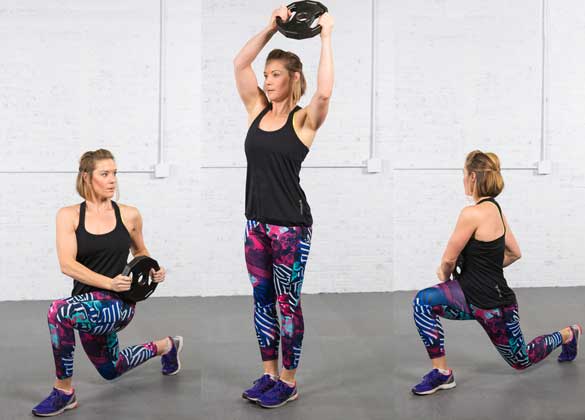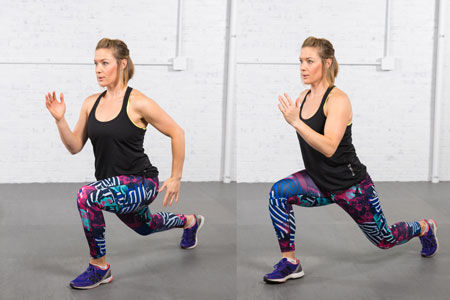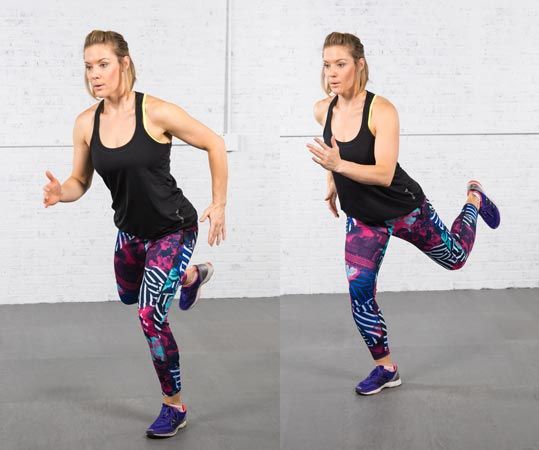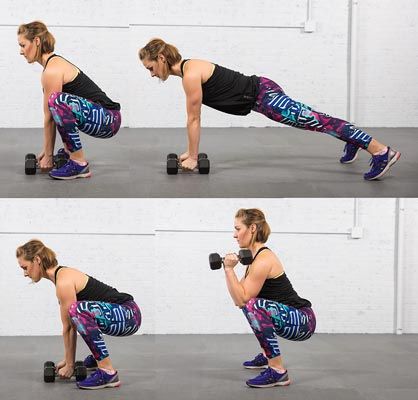
You know about the benefits of high-intensity interval training (HIIT), but it’s far from a one-size-fits-all format. HIIT has many exciting permutations to keep you and your clients motivated and seeing results. One such variation is a powerful protocol called metabolic strength conditioning. Have you tried it?
Think of metabolic strength conditioning as a more varied version of the traditional HIIT classes and sessions we see so much of in the fitness industry. “Metabolic strength conditioning challenges the entire body through high-intensity timed intervals that involve both strength and resistance moves with minimal rest in between,” says L.A.−based trainer Amy Dixon, a master trainer for BOSU, Schwinn and FitnessGlo, and creator of multiple HIIT programs, including a series of workout DVDs called Breathless Body.
While a typical HIIT session might get your clients close to max aerobic capacity with, perhaps, 30-second periods of sprinting or squat jumps, metabolic strength conditioning emphasizes more of a total-body interval experience using a format that could best be described as intervals within a circuit.
“An example of metabolic strength conditioning would be performing a series of three or four total-body exercises back to back for one minute each,” says Dixon. At least some of the exercises would include the use of resistance, such as walking lunges with dumbbell lateral raises. “After you complete the last move in the circuit, rest for two to three minutes and then repeat the circuit again,” says Dixon.
This combination of a circuit format with resistance exercises and back-to-back intervals that provide little chance for recovery makes metabolic strength conditioning especially effective for producing results.
“During a metabolic strength conditioning workout, the exercises alternate between non-competing muscle groups to capitalize on the rest periods between exercises,” Dixon explains. For example, you might perform burpees with push-ups in one round of intervals and squats with biceps curls in another. “Because exercises such as these work more muscles in less time, they lead to a larger metabolic response, which burns more calories and raises the metabolic rate,” says Dixon.
METABOLIC STRENGTH CONDITIONING CIRCUIT
Try this sample metabolic strength conditioning circuit for yourself or with your clients. Comprised of three rounds of interval exercises, including two consecutive sets of the same strength exercise followed by cardio drills, this workout was designed by Dixon for her new workout DVD, Breathless Body 4: GOING STRONG.
The first strength set calls for a medium weight (e.g., a 5- to 8-pound dumbbell) and the second strength set involves a heavier weight (e.g., a 10- to 20-pound dumbbell). Some clients might need more or less weight than the examples given here. The two strength intervals precede a third set of three cardio intervals. All exercise drills described below require fixed interval durations. Set your interval timer for the following:
- For strength intervals: Do 45 seconds of work with a medium weight and 15 seconds of recovery (60 seconds total). Repeat the same strength exercise a second time at 30 seconds of work with heavy weight and 30 seconds of recovery (60 seconds total). Move on to cardio intervals (see below).
- For cardio intervals: Do three intervals at 15 seconds of work and 15 seconds of recovery each (90 seconds total).

STRENGTH INTERVAL #1: Reverse Lunge Halo Chop
Stand with feet together and shoulders back, holding one dumbbell with both hands. Position the dumbbell so it’s horizontal to the floor and in front of your left hip. Step your right leg back into a reverse lunge and begin moving the arms in a large circular motion from left to right and then overhead and back down again. Perform the same sequence with a reverse lunge on your left side, raising the arms overhead and down in a circular motion from right to left. Alternate between right and left sides.

CARDIO INTERVAL #1: Switch Lunges
Stand tall with feet together. Step the right leg back into a reverse lunge and then immediately switch legs by jumping the right foot forward as you also jump the left leg back into a reverse-lunge position. Keep alternating sides. For a low-impact modification, step the right leg back into a reverse lunge; return to standing; step the left leg back into a reverse lunge; alternate.

STRENGTH INTERVAL #2: Front Lunge + Single-leg Deadlift + Reverse Fly + Reverse Lunge
Stand with feet hip-width apart, one dumbbell in each hand and arms at your sides. Step your right foot forward and bend the legs into a front lunge. Keeping your right foot where it is, lift your left foot off the floor behind you. Hold the left leg in the air parallel to the floor as you balance on your right leg and hinge at the waist into a single-leg deadlift. Your arms should be extended straight down toward the floor, palms facing each other. Still balancing on your right leg, perform one rep of a reverse fly, bringing your arms up to about shoulder height at your sides. Lower the arms to the starting position and straighten the torso as you step your left leg back to the floor. Bend both legs into a reverse lunge and step back to the starting position, feet together. That’s one repetition. Repeat the sequence on the other side; alternate sides.

CARDIO INTERVAL #2: Lateral Reverse Kicks
Step or hop to the right, leading with your right leg as you keep your left foot in the air, pushing or “kicking” your left leg behind you. Be sure to push back with the left heel, activating through the glutes on that same side. Step or hop to the left, pushing your right leg behind you; alternate.

STRENGTH INTERVAL #3: Frogger Plank + Biceps Curls
Stand with feet wider than hip-distance apart and place both dumbbells on the floor between your feet and slightly in front of you. Place one hand on each dumbbell, palms facing in, and walk or jump back into a straight-leg plank. Step or jump back, staying low in a wide-stance squat. With the legs still bent, lift the dumbbells off the floor and do one bilateral biceps curl, keeping the elbows close to your legs and lower than your knees. Place your hands/dumbbells back on the floor and step or jump back into a plank; repeat the sequence.

CARDIO INTERVAL #3: Frogger Squat Jumps
Move the dumbbells out of the way and get into a low squat with a wide stance. Place your hands on the floor between your feet and slightly in front of you. Step or jump back into a straight-leg plank then step or jump forward, returning to a low “frogger” squat. Immediately add a squat jump upward so your torso is upright but you are still in a semi-squat position (your legs should still be slightly bent). Return to the low, wide-stance squat and repeat the sequence. For a low-impact modification, eliminate the squat jump.





 by
by 








